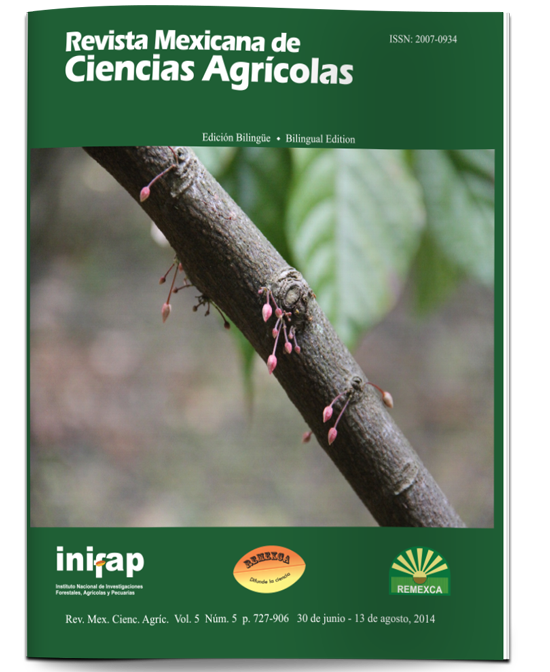Physalis peruviana L. response to inoculation with phosphorus solubilizing bacteria
DOI:
https://doi.org/10.29312/remexca.v5i5.913Keywords:
PGPR, Pseudomonas sp., Bacillus sp., Physalis peruviana L., biofertilizerAbstract
The implementation of solubilizing bacteria (BSF) as biological inoculants has become a promising alternative to provide phosphate nutritional need in tropical soils, reducing the use of chemical fertilizers. The objective was to evaluate 12 phosphate solubilizing strains (P04), isolated from the rhizosphere of Physalis peruviana L. on promoting growth of this crop. Pseudomonas sp. UVAG42, Bacillus sp. UVAG45, UVLO26 and UVLO22 were the strains producing more growth promotion under greenhouse conditions using 50% tricalcium phosphate (FT) with respect to an absolute control and 100% FT. These four strains were evaluated solubilization capacity of P04, with different carbon sources associated with root exudates, and production of kinds. The results showed that all four strains have the ability to solubilize PO4, where best results (p< 0.05) were obtained in the presence of malic acid, and producing indoles. Correlation analysis between all variables showed an association between them (p> 0.05) does not exist, demonstrating that possibly promoting growth was brought to a defined integration of various capacities for plant growth promoting bacteria (PGPR). Our findings show that phosphorus solubilization process based on the use of sources of low solubilization as FT, accompanied by BSF may be a viable farming alternative Physalis peruviana L., reducing the economic, ecological and social costs of this crop of great economic importance to the country as an export product.
Downloads
Downloads
Published
How to Cite
Issue
Section
License
The authors who publish in Revista Mexicana de Ciencias Agrícolas accept the following conditions:
In accordance with copyright laws, Revista Mexicana de Ciencias Agrícolas recognizes and respects the authors’ moral right and ownership of property rights which will be transferred to the journal for dissemination in open access. Invariably, all the authors have to sign a letter of transfer of property rights and of originality of the article to Instituto Nacional de Investigaciones Forestales, Agrícolas y Pecuarias (INIFAP) [National Institute of Forestry, Agricultural and Livestock Research]. The author(s) must pay a fee for the reception of articles before proceeding to editorial review.
All the texts published by Revista Mexicana de Ciencias Agrícolas —with no exception— are distributed under a Creative Commons License Attribution-NonCommercial 4.0 International (CC BY-NC 4.0), which allows third parties to use the publication as long as the work’s authorship and its first publication in this journal are mentioned.
The author(s) can enter into independent and additional contractual agreements for the nonexclusive distribution of the version of the article published in Revista Mexicana de Ciencias Agrícolas (for example include it into an institutional repository or publish it in a book) as long as it is clearly and explicitly indicated that the work was published for the first time in Revista Mexicana de Ciencias Agrícolas.
For all the above, the authors shall send the Letter-transfer of Property Rights for the first publication duly filled in and signed by the author(s). This form must be sent as a PDF file to: revista_atm@yahoo.com.mx; cienciasagricola@inifap.gob.mx; remexca2017@gmail.
This work is licensed under a Creative Commons Attribution-Noncommercial 4.0 International license.



